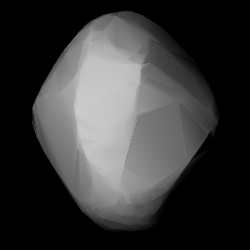212 Medea
Appearance
 3D convex shape model of 212 Medea | |
| Discovery | |
|---|---|
| Discovered by | Johann Palisa |
| Discovery date | 6 February 1880 |
| Designations | |
| (212) Medea | |
| Pronunciation | /mɪˈdiːə/[1] |
Named after | Medea |
| A880 CA, 1930 FW | |
| Main belt | |
| Orbital characteristics[2] | |
| Epoch 31 July 2016 (JD 2457600.5) | |
| Uncertainty parameter 0 | |
| Observation arc | 136.05 yr (49694 d) |
| Aphelion | 3.4422 AU (514.95 Gm) |
| Perihelion | 2.78929 AU (417.272 Gm) |
| 3.11575 AU (466.110 Gm) | |
| Eccentricity | 0.10478 |
| 5.50 yr (2008.8 d) | |
| 28.1280° | |
| 0° 10m 45.156s / day | |
| Inclination | 4.2636° |
| 313.478° | |
| 100.91° | |
| Physical characteristics | |
| 136.12±2.5 km[2] 144.13 ± 7.23 km[3] | |
| Mass | (1.32 ± 0.10) × 1019 kg[3] |
Mean density | 8.41 ± 1.43 g/cm3[3] |
| 10.283 h (0.4285 d)[2] 10.12 h[4] | |
| 0.0465±0.002 | |
| DCX:[4] | |
| 8.28 | |
212 Medea is a very large main-belt asteroid that was discovered by Johann Palisa on February 6, 1880, in Pola, and was named after Medea, a figure in Greek mythology.[5]
Photometric observations of this asteroid in 1987 gave an incomplete lightcurve with a period of 10.12 ± 0.06 hours and a brightness variation of 0.13 in magnitude. This object has a spectrum that matches a DCX: classification.[4] Lightcurve data has also been recorded by observers at the Antelope Hill Observatory (H09), which has been designated as an official observatory by the Minor Planet Center. They found a period of 10.283 hours with a brightness variation of 0.08 magnitude.[6]
References
[edit]- ^ Noah Webster (1884) A Practical Dictionary of the English Language
- ^ a b c Yeomans, Donald K., "212 Medea", JPL Small-Body Database Browser, NASA Jet Propulsion Laboratory, retrieved 12 May 2016.
- ^ a b c Carry, B. (December 2012), "Density of asteroids", Planetary and Space Science, vol. 73, pp. 98–118, arXiv:1203.4336, Bibcode:2012P&SS...73...98C, doi:10.1016/j.pss.2012.03.009. See Table 1.
- ^ a b c di Martino, M.; et al. (July 1995), "Intermediate size asteroids: Photoelectric photometry of 8 objects.", Astronomy and Astrophysics Supplement, vol. 112, pp. 1–7, Bibcode:1995A&AS..112....1D.
- ^ Schmadel Lutz D. Dictionary of Minor Planet Names (fifth edition), Springer, 2003. ISBN 3-540-00238-3.
- ^ "Lightcurve Results". Archived from the original on 25 July 2011. Retrieved 9 March 2008.
External links
[edit]- Lightcurve plot of (212) Medea Archived 31 August 2020 at the Wayback Machine, Antelope Hills Observatory
- The Asteroid Orbital Elements Database
- Minor Planet Discovery Circumstances
- Asteroid Lightcurve Data File
- 212 Medea at AstDyS-2, Asteroids—Dynamic Site
- 212 Medea at the JPL Small-Body Database
